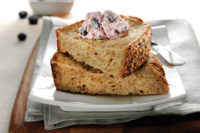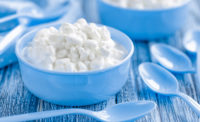The prebiotic fiber polydextrose fits that description. The trick lies in what Steele calls polydextrose’s “complex structure,” which ferments only slowly and incompletely throughout the colon. In addition to providing satiety, this “leads to many positive health benefits, including optimal pH within the colon, reduced carcinogenic compounds throughout the colon, improved bowel function and minimal gas production,” she said. In contrast, other prebiotic fibers are digested quickly and completely in the upper portion of the colon, which can cause significant gas production and result in digestive stress.
Polydextrose appears to be as easy on formulations, as well. Steele calls it “highly flexible” and available in liquid and powder forms with excellent process and shelf stability. She said her company’s brand “has found success across all segments of the food and beverage industry, where it is recognized for its clean taste, ease of formulation and low cost in use.”
Thanks to its bulking properties and energy contribution of 1 kcal per gram, polydextrose can also help manufacturers replace sugar and fat without compromising flavor or mouthfeel. In fact, a wide range of fibers are showing up in dairy products. Depending on the fiber used, the enhanced mouthfeel could make the product more indulgent tasting without the negative of added fat, Raban said. She thinks fiber fortification offers exciting possibilities.
“A fiber-fortified, skim milk-based smoothie would not only give consumers the nutrition associated with milk, but would add to the fiber content as well,” she said. “And since most fibers are easy to formulate with, it gives the dairy industry a great opportunity to expand a small segment of the market.”
Composition skills
The popularity of satiety-inducing ingredients speaks to the ambient concern consumers have about weight. Troha points out that Euromonitor International values the weight management food and beverage markets in 2012 at $144 billion globally. By 2015, Euromonitor predicts that the market will hit $162 billion at constant 2010 prices. But satiety isn’t the only weight-management game in town.
“Consumers clearly see the benefits of getting rid of body fat, and not just getting rid of weight,” Troha notes. “While dieting continues to be a growing frustration, consumers are hungry for safe, natural alternatives to improve their body composition.”
Enter CLA, isomers of linoleic acid found primarily in ruminant meat and milk, and in eggs. Studies demonstrate that CLA can decrease both the number and size of fat cells. It does so by inhibiting lipoprotein lipases that store triglycerides in fat cells while goosing carnitine palmitoyltransferase, which increases fat metabolism. Meanwhile, CLA may also increase the rate of fat cell death. The upshot: improved body composition.
But while grass-fed animals are the best sources of CLA, supplying fully three to five times the CLA of grain- and silage-fed livestock, most Americans consume meat and milk from the latter. Consumers are increasingly aware of this, and of how “changes during the past 30 years in how cattle are raised, combined with the trend toward low-fat dairy, have greatly reduced the amount of CLA we get through our diets,” Troha said. “So if consumers want to get enough CLA, they will consider fortified foods or supplements.”










